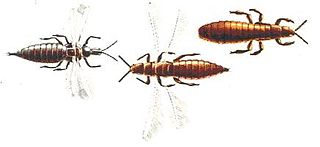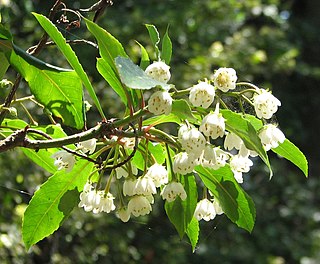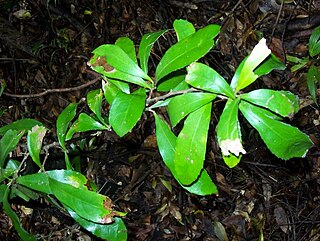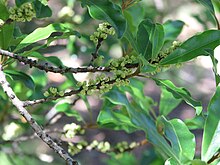
Ficus macrophylla, commonly known as the Moreton Bay fig or Australian banyan, is a large evergreen banyan tree of the Mulberry Family (Moraceae) native to eastern Australia, from the Wide Bay–Burnett region in the north to the Illawarra in New South Wales, as well as Lord Howe Island where the subspecies F. m. columnaris is a banyan form covering 2.5 acres or more of ground. Its common name is derived from Moreton Bay in Queensland, Australia. It is best known for its imposing buttress roots.

Ficus rubiginosa, the rusty fig or Port Jackson fig, is a species of flowering plant native to eastern Australia in the genus Ficus. Beginning as a seedling that grows on other plants (hemiepiphyte) or rocks (lithophyte), F. rubiginosa matures into a tree 30 m (100 ft) high and nearly as wide with a yellow-brown buttressed trunk. The leaves are oval and glossy green and measure from 4 to 19.3 cm long and 1.25 to 13.2 cm wide.

Thrips are minute, slender insects with fringed wings and unique asymmetrical mouthparts. Entomologists have described approximately 6,000 species. They fly only weakly and their feathery wings are unsuitable for conventional flight; instead, thrips exploit an unusual mechanism, clap and fling, to create lift using an unsteady circulation pattern with transient vortices near the wings.

Melastoma affine, also known by the common names blue tongue or native lassiandra, is a shrub of the family Melastomataceae. Distributed in tropical and sub-tropical forests of India, South-east Asia and Australia, it is a plant of rainforest margins. Bees are the principal pollinators of this species.

Anopterus macleayanus, commonly known as Queensland laurel or Macleay laurel, is a shrub or small tree in the family Escalloniaceae. It is native to Queensland and New South Wales in Australia.

Ficus obliqua, commonly known as the small-leaved fig, is a tree in the family Moraceae, native to eastern Australia, New Guinea, eastern Indonesia to Sulawesi and islands in the southwestern Pacific Ocean. Previously known for many years as Ficus eugenioides, it is a banyan of the genus Ficus, which contains around 750 species worldwide in warm climates, including the edible fig. Beginning life as a seedling, which grows on other plants (epiphyte) or on rocks (lithophyte), F. obliqua can grow to 60 m (200 ft) high and nearly as wide with a pale grey buttressed trunk, and glossy green leaves.

Pouteria australis, also known by the synonym Planchonella australis, is a medium to tall rainforest tree of the family Sapotaceae native to Queensland and New South Wales, Australia. It is known by the common name black apple, wild plum, yellow buttonwood, black plum and yellow bulletwood.

Breynia oblongifolia, commonly known as coffee bush, grows naturally in Australia and New Guinea as shrubs up to 3 m (10 ft) in height. The species produces alternate, distichous, ovate leaves 20–30 mm (0.8–1.2 in) long by 10–20 mm (0.4–0.8 in) wide. Small, green flowers are produced in spring and summer, and these are followed by orange or pink berries about 6 mm (0.24 in) diameter that turn black when fully ripe.

Glochidion ferdinandi, with common names that include cheese tree, is a species of small to medium–sized trees, constituting part of the plant family Phyllanthaceae. They grow naturally across eastern Australia, from south–eastern New South Wales northwards to northern and inland Queensland, in rainforests and humid eucalypt forests. Frugivorous birds such as pigeons, figbirds and parrots consume its fruit.

Myrsine variabilis, synonym Rapanea variabilis, known as the muttonwood or variable muttonwood is a tree of eastern Australia. The range of natural distribution is from near Milton in southern New South Wales to the McIlwraith Range in far north Queensland.

Telopea mongaensis, commonly known as the Monga waratah or Braidwood waratah, is a shrub or small tree in the family Proteaceae. Endemic to Australia, it grows at high altitude in south eastern New South Wales, where it is often seen in moist areas at the edge of rainforest or by streams in eucalyptus forests. Growing to 6 m (20 ft) high, it has narrow green leaves 4–18 cm (1.6–7.1 in) in length, and 0.5–2 cm (0.20–0.79 in) wide. In spring bears many red flowerheads, each made up of 28 to 65 individual flowers.

Wilkiea huegeliana is a common small tree of rainforest in eastern Australia. Common names include common wilkiea, tetra beech, and veiny wilkiea. Originally described by French naturalist Louis René Tulasne, it was given its current name by Alphonse Pyramus de Candolle.

Trochocarpa montana, the mountain tree heath, is an Australian shrub or small tree. It occurs at high altitude from the Barrington Tops to the Dorrigo region of northern New South Wales.

Clerodendrum tomentosum, known as the downy chance, hairy lolly bush, hairy clairy or hairy clerodendrum is a shrub or small tree occurring in eastern and northern Australia. Distributed from Batemans Bay in southern coastal New South Wales, Queensland, Northern Territory, Western Australia, and New Guinea.

Helicia glabriflora is a species of rainforest shrubs or small trees occurring in eastern Australia. Common names include smooth or pale helicia, pale, leather or brown oak. They grow naturally in a variety of different rainforest types from the Illawarra, New South Wales to the Townsville area, Queensland. Of all the global diversity of approximately one hundred Helicia species, this one species naturally grows the furthest south, in the Minnamurra Rainforest and the Robertson area, Illawarra, New South Wales, there observed more on the relatively fertile basalt and alluvial soils.

Pouteria myrsinoides is an Australian tree in the family Sapotaceae. The common names include yellow plumwood, axe-handle wood and blunt-leaved coondoo. It occurs in seaside rainforests and drier rainforests from the Forster, New South Wales to the Lakeland Downs in tropical Queensland. The subspecies reticulata occurs on Lord Howe Island and in New Caledonia.

Notelaea ligustrina, known as the privet mock olive, native olive, doral or silkwood, is a plant in the olive family, found in south eastern Australia. It is known to grow in and near rainforests south of Monga National Park in New South Wales, and into Victoria and the island state of Tasmania. The specific epithet ligustrina refers to the Privet, which it resembles.

Acacia longissima, known colloquially as long-leaf wattle or narrow-leaf wattle, is a species of Acacia native to eastern Australia.

Halfordia is a genus of plants in the family Rutaceae containing the single species Halfordia kendack commonly known as kerosenewood, southern ghittoe or saffronheart, is a rainforest plant that is native to eastern Australia, New Guinea and New Caledonia. It is a shrub or tree with elliptical to egg-shaped leaves with the narrower end towards the base, panicles of white, greenish white or yellowish flowers and purple to bluish black, spherical to oval fruit.

Myrsine richmondensis, known as the ripple leaf muttonwood or purple-leaf muttonwood, is a very rare shrub of coastal areas of New South Wales; from Coraki on the Richmond River north to Mount Warning.




















